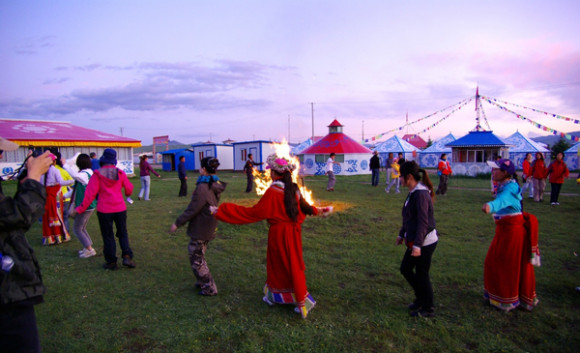Xiahe County & Sangke Grasslands
Xiahe is a county in Gannan Tibetan Autonomous Prefecture, Gansu province, the People's Republic of China. Xiahe is found in the southern portion of Gansu province, along the western border with Qinghai province. It lies along the Daxia and Zhao rivers. It is on the northeast edge of the Qinghai-Tibet Plateau. The average elevation is 2900 to 3100 m with the highest being 4636 m and lowest is 2160 m. Xiahe used to be part of Qinghai when it was under the control of Chinese Muslim General Ma Qi. It was the site of bloody battles between Muslim and Tibetan forces.
It is home to the famed Labrang Tibetan Buddhist monastery, one of the largest Tibetan Buddhist monasteries outside of the Tibet Autonomous Region. The town is populated largely by ethnic Tibetans, as well as some Hui and Han Chinese. The area is highly rural and pastoral (including yak and other animal rearing). The geography is mountainous. In recent years it has become a tourist attraction. The town was named Xiahe in 1928.
Of the Gannan Tibetan Autonomous Prefecture, Xiahe is in fact no more than a simple slat-wood settlement along the Daxia River physically and socially orbiting the impressive Labuleng, mainland China's largest Tibetan monastery. Hugged up against the surrounding mountainside, the picturesque state known also as the Labrang Lamma monastery was built in 1710 and accommodates six Buddhist seminaries and over 500 monks of the Yellow Hat sect.
Buddhists from across the region come to worship at Labuleng, contributing to the colorful activity that gives Xiahe its attractive allure. A three-kilometer kora (spiritual walking circuit) halos the area and is heavy with foot traffic from dawn to dusk, whereby crimson-robed monks and natively dressed Amdo pilgrims spinning hand-held mani wheels orbit the monastery while breathlessly prostrating themselves and chanting.
In between turning 1,200 vibrantly painted wooden prayer wheels, the resplendently ornamented nomads rest beneath stupas to chat and sip yak butter tea, a veritable portrait of Tibetan culture.
Visiting the holy capital city of Lhasa on the roof of the world may sound thrilling, but increasing occupation and rampant tourism has rapidly diluted it from the serene getaway it once was. Xiahe, known as Little Lhasa, in the Gansu highlands is a more intimate, and conveniently closer, alternative for those desiring a secluded retreat of unadulterated Tibetan culture.
Local Interesting Festivals
In Xiahe, the Tibetans have very unique festivals not like those who live in Tibet. For two years, many tourists have flocked here to take part in: Sunning Buddha Festival (13th, first month of the lunar new year), Festival of Sorcerer's Dance in a Trance (14th, first month of the lunar new year), Ghee Lamp Fair (15th, first month of the lunar new year), Prayer Meeting Festival (July and October), Tibetan Opera performances, Grassland Xianglang Festival, Horse Race Festival, Ethnic Sports Meeting, Boyu Deflower Festival, Black Water Valley Worship Holy Water Festival, Pine Shack Lantern Festival, Lotus Mountain Flower Fair, Ten Thousand People Tug-of-War, and Thrusting Arrow Festival. At the same time, the Tibetans' customs in Xiahe are very different from the Tibetans living in Tibet. They are also very attractive.
Transportation
From Langzhou to Xiahe, busses leave the North Bus Station at 7am, 8:30am and 2pm (5 hours).







